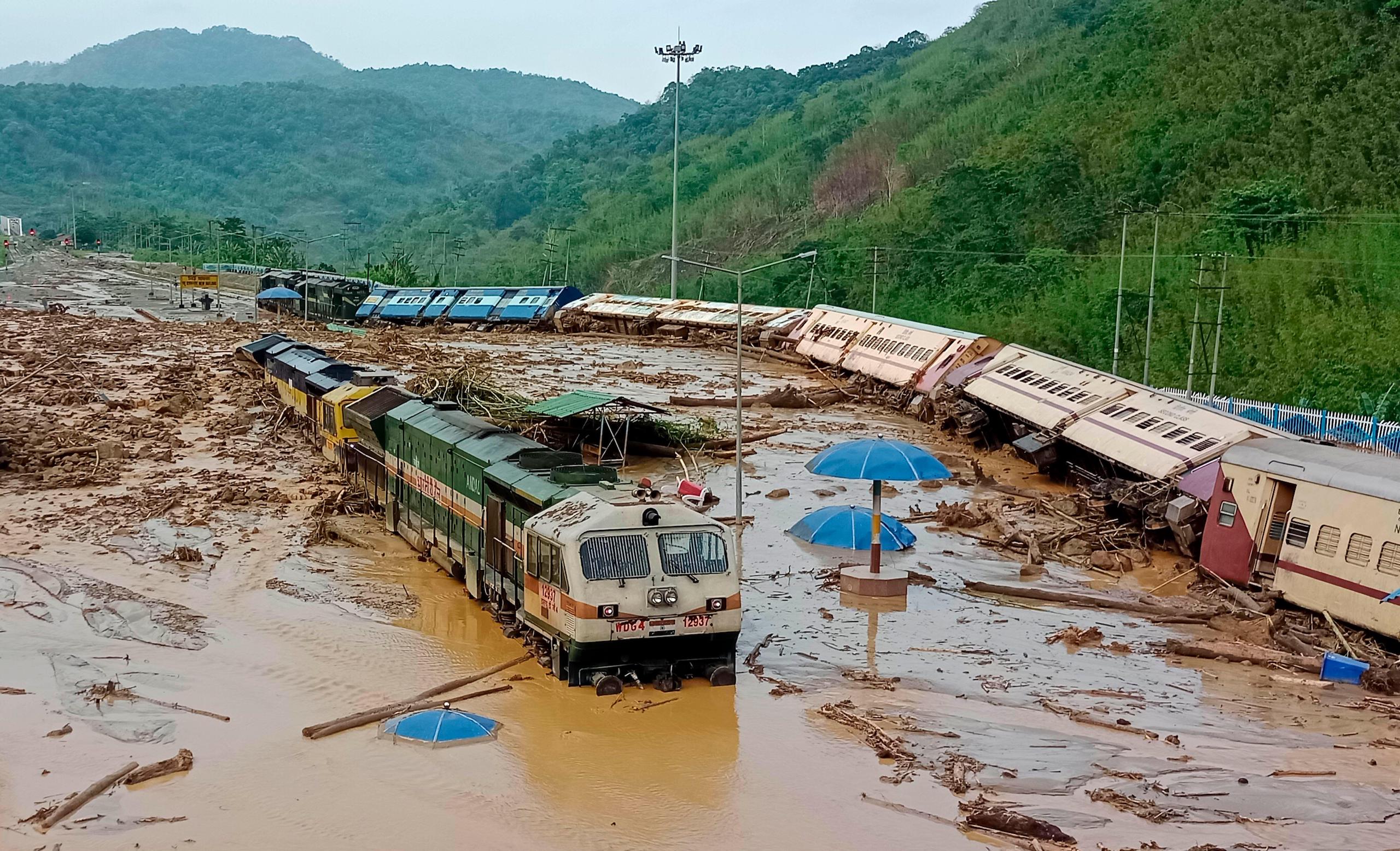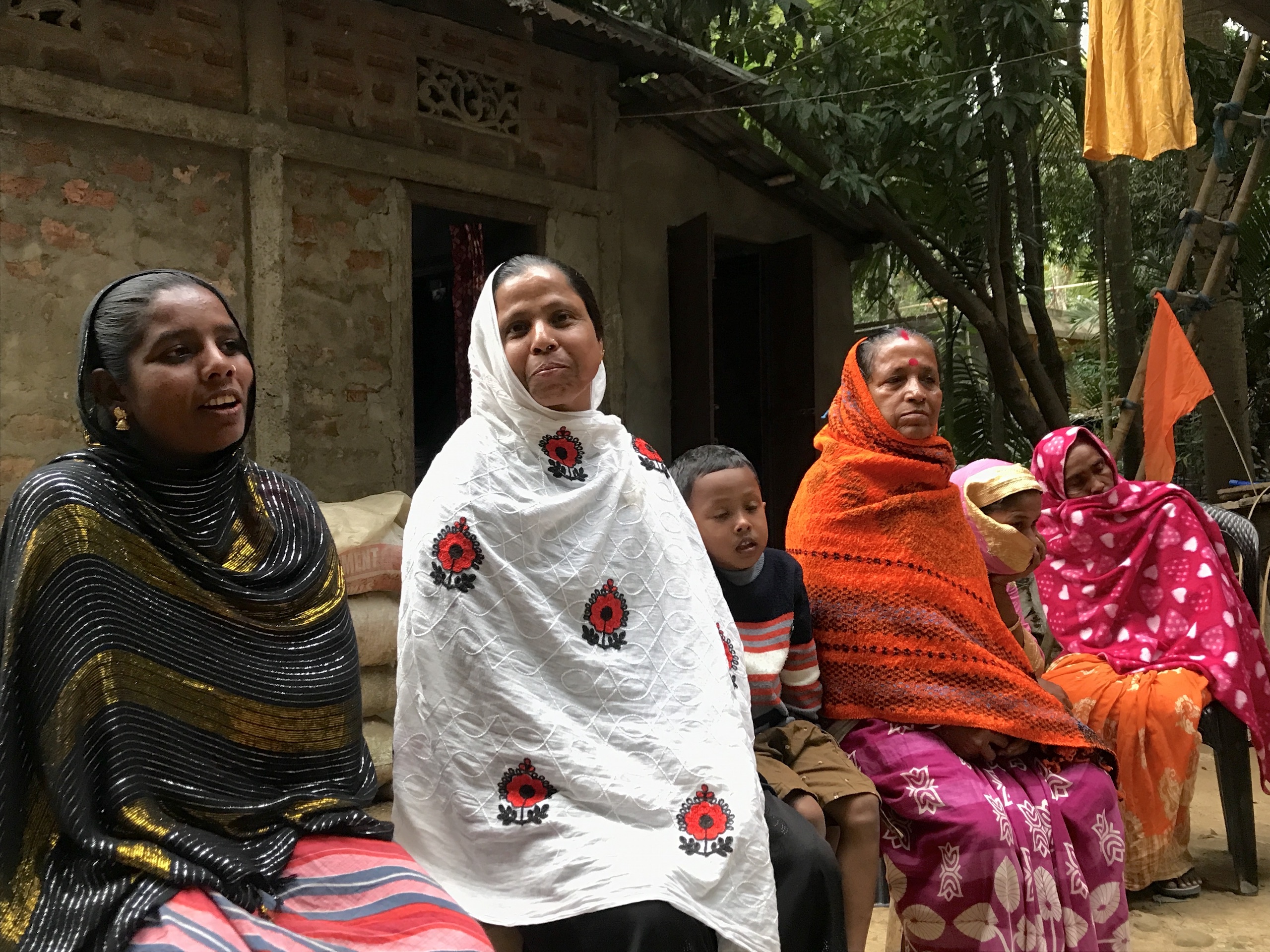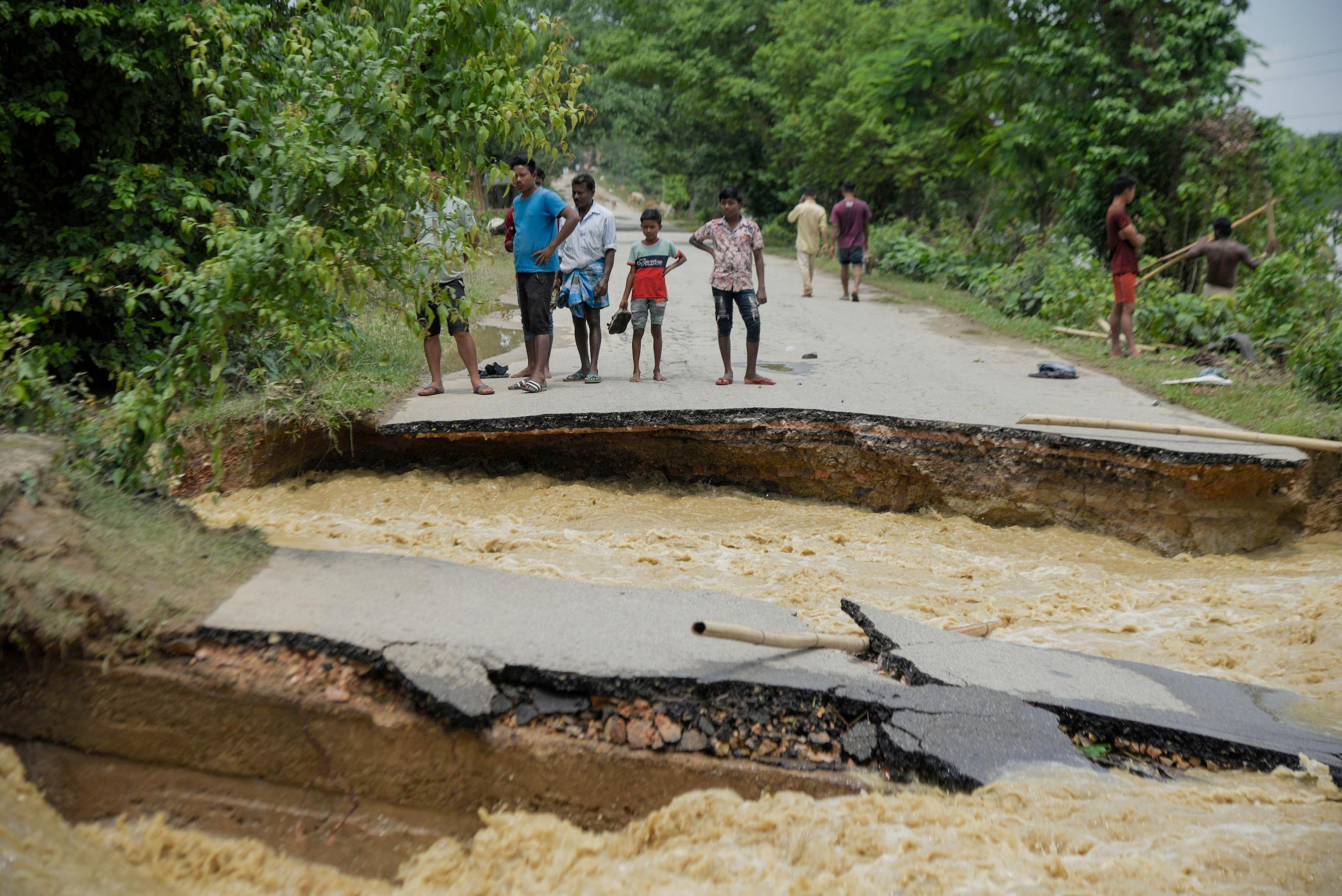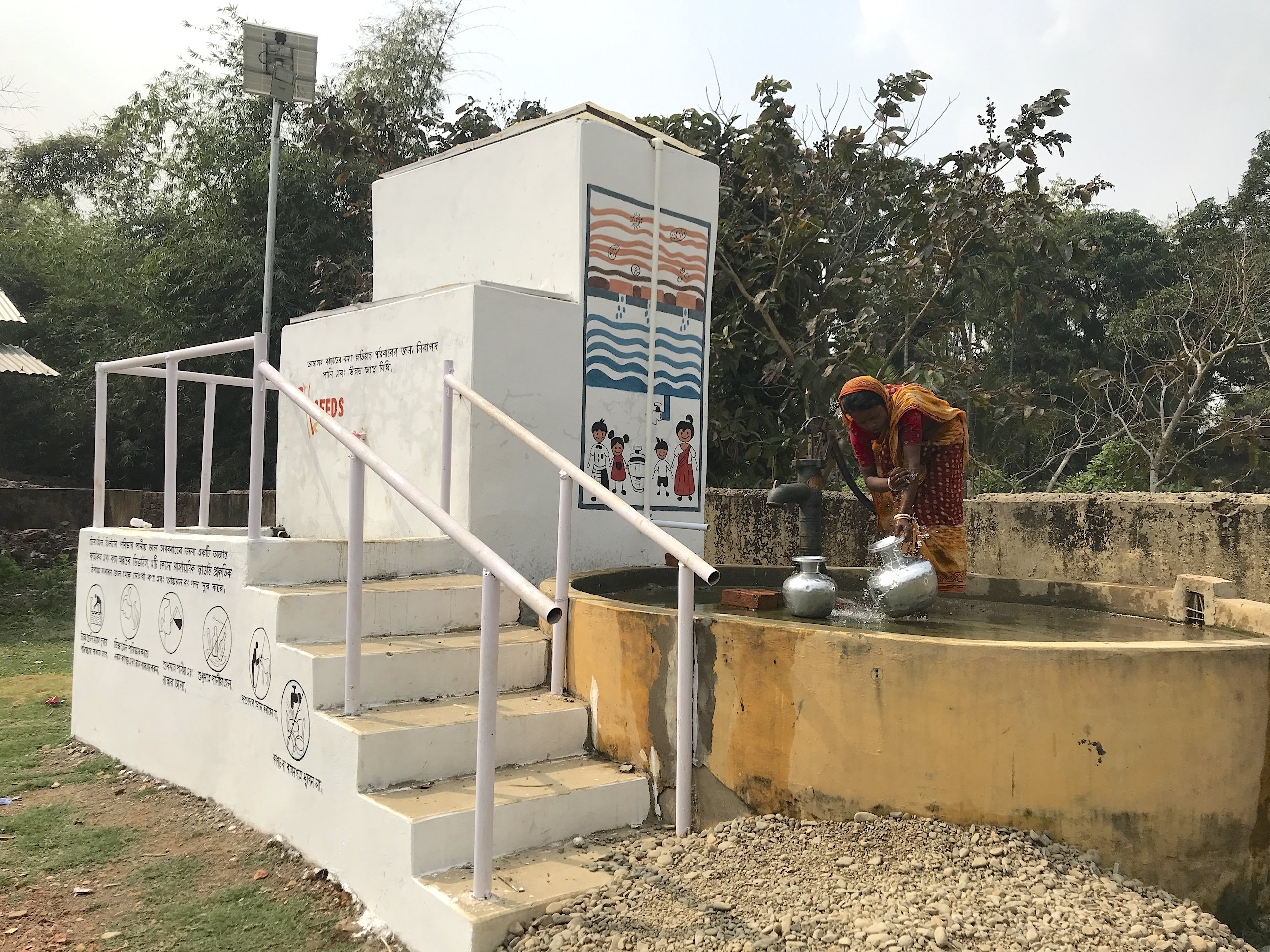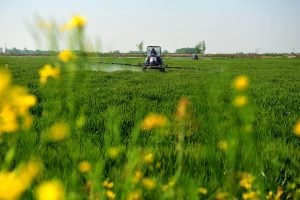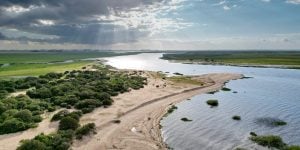Two years after catastrophic floods devastated over 300 households in Gumra Grant village in Assam state, residents like Shahra Begum and her three children are still reeling from the trauma.
“I will never forget the banna [flood] that hit us two years ago. It was pouring and soon we were in chest-high water. I was trapped with my three children. All we could see was muddy water with dead cattle floating on it,” says the 35-year-old.
Stranded and with no government assistance, the villagers were forced to improvise rafts from the stems of banana trees to escape to higher ground.
Gumra Grant, in Cachar district, lies just 500 metres from the Bangladesh border. Begum says such severe flooding had never been seen in her village before the events of May and June 2022, which affected nearly 5.4 million people across Assam, claiming 200 lives.
Manu Gupta, director of New Delhi-based SEEDS (Sustainable Environment and Ecological Development Society), a non-governmental organisation specialising in disaster mitigation, notes that natural disasters have doubled over the past two decades, adding new areas to India’s flood hazard map.
“What is extremely worrisome is that areas like Cachar in Barak Valley, are now considered high-risk districts. There was neither a warning system nor an emergency response system in place,” says Gupta. Currently, 225 districts in India, with a combined population of 270 million people, face multiple hazards due to climate change-induced disasters. This number is expected to rise to 315 million by 2030, he warns.
In response, SEEDS has collaborated with the district administration to enhance disaster resilience by promoting community-based strategies. Following her ordeal, Begum joined a 15-member village task force focused on disaster preparedness. The group, made up of eight men and seven women, conducts regular mock drills and trains residents in emergency procedures.
“The floods of 2022 taught us that we can’t rely on the government to rescue us during a calamity,” says Abdul Sattar, president of the Gumra Grant task force. “Villagers have learnt how to make life-jackets using discarded plastic bottles, evacuate people and identify safe drinking water sources.”
A new climate hotspot
Occupying just 2.4% of India’s land mass, Assam accounts for almost 9.4% of the country’s flood-prone areas, with over 40% of the state’s land considered at risk.
Traditionally, the Brahmaputra Valley has been the focal point for floods, overshadowing Barak Valley. 2022 bucked that trend.
Although some districts, like Cachar, had a disaster management plan in place for 2022-23, Barak Valley was ill-prepared for the deluge. A report by the Assam State Disaster Management Authority notes Assam and Meghalaya experienced 327% and 663% excess rainfall, between 12 May and 18 May, respectively. In the second wave, between 12 June and 18 June, they each recorded 235% and 329% excess rainfall.
Heavy rainfall, coupled with breaching of the Barak River’s embankment near Silchar and multiple landslides in the neighbouring states of Meghalaya and Nagaland, brought the region to its knees as road and railway networks were disrupted. “We have a number of rivers that join the Barak River and flow into Bangladesh. We are no stranger to banna but they used to be minor events. I’ve never witnessed anything like what happened two years ago and we got no compensation from the government,” says Shefali Das, a villager in her 60s from Gumra Grant.
It is a similar tale in Mahadevpur Part 1 village. “My house and toilet were washed away in the floods. I’ve received no compensation from the government for my losses. My tin-roofed house is still half broken,” says Promila Das, a 68-year-old widow.
“I suffered a loss of at least INR 30,000 [USD 360] in the floods, but the government hasn’t given me a single rupee,” says 60-year-old Sunando Das from the same village.
Governance and infrastructure failures
Shamim Ahmed Laskar is the district project officer at Cachar’s District Disaster Management Authority (DDMA). “We are aware that a total of four to five lakh [400-500,000] families in the district suffered due to the 2022 floods, but we compensated only 81,544 families and disbursed INR 40 crore [USD 4.8m]. The revenue department failed to enrol all the flood-affected people,” he says, acknowledging the district administration’s failings.
Laskar cites the long neglect of sluice gates and embankments as significant contributors to the events of 2022. Changing rainfall patterns, unplanned urbanisation and the lack of coordination between government agencies all contributed to exacerbate Cachar’s vulnerability to floods, he says.
Some sluice gates, like the one in Mahadevpur Part 1 village, had remained blocked for almost 30 years. The result, says Laskar, was “excess floodwater couldn’t drain out as the sluice gate was unserviceable, with villages inundated for weeks.”
He adds: “The embankments of the Barak River hadn’t seen maintenance since 1965. When it rained heavily, a part of the embankment breached near Silchar city, leading to massive flash floods.”
Past warnings also went ignored. A 2014 report, submitted to the Assam State Disaster Management Authority noted there were 26 major sluice gates and approximately 738 kilometres of embankments set up to deal with floods, but “most of these embankments have outlived their lifespan” leading to regular breaches during monsoon season, causing extensive flood damage.
Parthankar Choudhury, head of the Department of Ecology and Environmental Science at Assam University, explains how unplanned development makes an already bad situation worse.
“The stormwater drains in Silchar are 50-60 years old. Hills are being cut, leading to landslides. Low-lying areas and wetlands have been filled for development. In rural areas, people are filling low-lying lands and raising their houses to avoid flood waters. Where will the runoff go?” he questions.
Public services and buildings, like the Jalalpur Block Primary Health Centre in Katigorah, were also affected.
“Since our building is old, it’s at a lower level compared to newer constructions. In the first wave of floods, our outpatient and in-patient department went under water. Barely had we recovered when the second wave hit,” says Debjyoti Roy, the centre’s community mobiliser.
Building back better
As well as laying bare the district’s flawed infrastructure and governance, the floods of 2022 were a wake-up call that more needed to be done. New government-led initiatives include training 421 volunteers as Apda Mitras, disaster response coordinators, setting up multipurpose flood centres and developing an emergency response app called Rahat.
Communities have also taken proactive steps. Baleswar Higher Secondary School, which was inundated for weeks, losing furniture and equipment, now conducts simulated exercises for students.
“Through our school management development committee, which has parents as members, the community is also being trained in disaster preparedness,” says Muchabbir Ali, the school’s principal. 180 frontline health workers, known as accredited social health activists, or ASHA for short, have also been trained “to give CPR [cardiopulmonary resuscitation]; organise relief camps and disinfect water,” says Roy of Jalalpur BPHC.
To address water safety, SEEDS has installed Terra filters in Cachar villages prone to saline groundwater. These filters, developed by the Defence Research and Development Organisation (DRDO), are designed to remain functional even during floods, providing safe drinking water to 1,500 families.
Two years on, the narrative of resilience and preparedness in Barak Valley is still unfolding. The district administration asserts that it is better equipped to manage future disasters. According to Laskar, necessary repairs have been made, yet the effectiveness of these measures and ongoing maintenance will only be truly verified by future disasters. With the apparent early arrival of monsoon season, the real test of these preparations has just begun.
